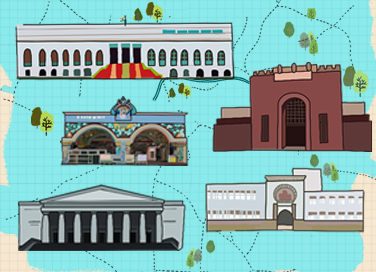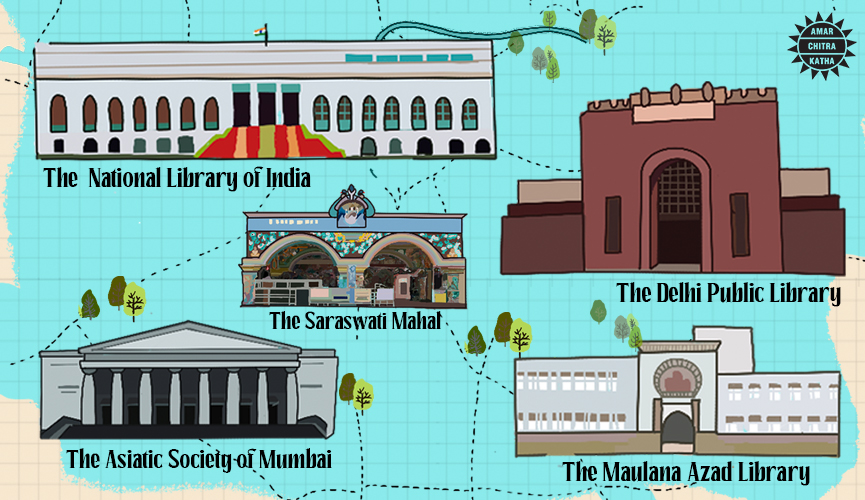Must-See Libraries in India
- August 12, 2021


Must-See Libraries in India
- August 12, 2021
Premium
By Dheer Sanghi
India has one of the longest and richest histories of any nation in the world. From being home to one of the oldest civilisations: the Indus Valley civilization, to the Mughal empire, to British rule, to finally becoming an independent nation; preserving India’s story is pertinent to our national identity and culture. One of the best mediums to do so are libraries. Filled with influential books, important manuscripts, and inspiring art, libraries make knowledge accessible to the masses. India has hundreds of such libraries, all worth visiting, but this article will focus on a few that you must see.

Located in Kolkata, the National Library of India is the nation’s largest library in terms of volume. Housing over 2.2 million books, manuscripts, and records, its purpose is to amass and maintain printed texts made in India. The history of the National Library of India is a fascinating one. Starting off as the Imperial Library (founded in 1891) by merging smaller libraries in the area, it also doubled up as the official residence of the Governor-General of India until Independence. It was only open to government officials, however, restricting the public from accessing texts. In 1948, the new Indian government signed the Imperial Library (Change of Name) Act, resulting in the library being called the National Library. Another change twenty eight years later added ‘of India’ to the library’s name. Furthermore, a decade ago, the building made headlines as the Ministry of Culture decided to restore it. Part of the restoration process resulted in a secret room being found, on the ground floor with no entrances and exits. Many have theorized the purpose of this thousand square foot room, but no proof has ever been found. Due to its historical importance, the library was opened to the public on February 1, 1953, and can now be visited by anyone on any day with the exception of Independence Day, Republic Day, and Gandhi Jayanti.
To receive more such stories in your Inbox & WhatsApp, Please share your Email and Mobile number.
Another library that has colonial roots is the library of The Asiatic Society of Mumbai. Created with the goal of “promoting useful knowledge, particularly such as is now immediately connected with India,” the society preserves original documents and texts, conducts research, and acts as a forum to discuss relevant issues. Created as the Literary Society of Bombay in 1804 by Sir James Mackintosh, the organization became affiliated with the Royal Asiatic Society in 1830. A few years after gaining independence, the group separated from the Royal Asiatic Society and has been funded by the central government ever since. The library holds very interesting books, over 15000. Additionally, many thousand ancient manuscripts, including some written on palm leafs. 16th Century illustrated passages from the Mahabharata and the 13th century manuscript of the ‘Vasupujyacharita’ that talks about the twelfth Jain Tirthankara are just some of the historical documents stored. The society also has one of two known original copies of Dante’s Divine Comedy, one of its prized possessions. Although the library is only open to members, all files have been digitised, and can be found easily online.
The Maulana Azad Library in Aligarh is the largest university library in Asia. With over 1.8 million books, the library’s impressive collection is matched with an impressive surrounding. Seven storeys high, the building is also bordering 4.75 acres of gardens and lawns. Though only 60 years old, the foundation of the building was laid in 1877 under the name Lytton Library after the then Viceroy of India. Nevertheless, the current building was inaugurated in 1960 by Prime Minister Jawaharlal Nehru.
The last library on this list is the Saraswathi Mahal Library. Located in Thanjavur in Tamil Nadu on the beautiful grounds of the Thanjavur palace, this library is one of the oldest in all of Asia, founded in the 16th century. Apart from the various books, this library also contains many precious ancient manuscripts and texts in a multitude of languages. Started by the Nayak Kings of the region as a private library for their own enjoyment and learning, Saraswathi Mahal was not always open to the public. The Kings however only ruled until 1676. Luckily, their successors, the Maratha rulers who captured Thanjavur improved the library, adding to the collection and employing Pandits to go far and wide across India to find new works. The library was opened to the public in 1918 and anyone can visit.
India has a plethora of magnificent libraries holding vast amounts of knowledge and culture in many different languages. Take some time to visit one close to you, or if possible, one of these four!
To receive more such stories in your Inbox & WhatsApp, Please share your Email and Mobile number.

Comic of The Month
Dr Kotnis in China
In 1938, twenty-eight-year-old Dr Dwarkanath Kotnis was part of a medical mission that India sent to aid China in its war with Japan. Dr Kotnis was committed to saving lives, even in the precarious war-time situation. He remained behind to continue his work in China after the rest of his group returned. He was, and remains, a selfless and fearless hero to the people of China and India alike.